European Burmese: Info, Pictures, Characteristics & Facts
Updated on
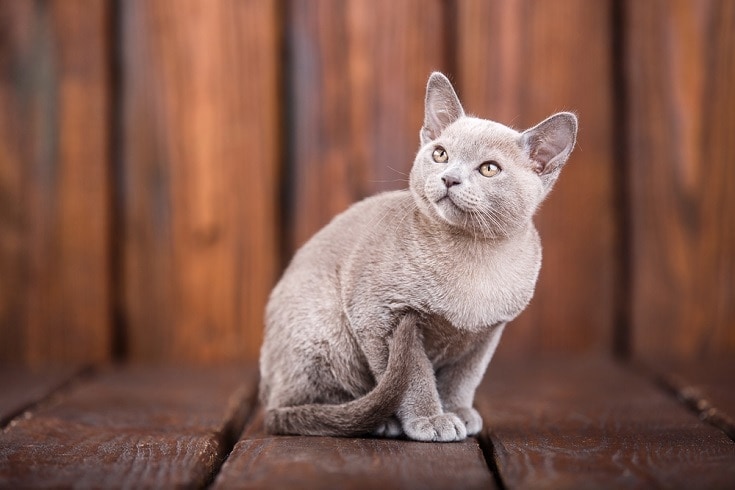
Did you know that there are two types of Burmese cats? Though both originated from the stock and most cat registries don’t consider the two to differ genetically, there are differences between the European and the American Burmese. Read on to learn everything you need to know about the beautiful European Burmese, including its history and how it differs from the American variety.
| Height | 8–13 inches |
| Weight | 7–14 pounds |
| Lifespan | 12–15 years |
| Colors | Brown, blue, chocolate, cream, lilac, red, blue tortoiseshell, brown tortoiseshell, chocolate tortoiseshell, and lilac tortoiseshell |
| Suitable for | Families with children and other pets, people that spend a lot of time at home and are looking for a companion |
| Temperament | Affectionate, cuddly, devoted, docile |
The European Burmese is a lot like the traditional Burmese, with the exception of its body type and eye shape. The European variety has a slim, elegant, roundly contoured body that is more moderately built than the regular Burmese. Its eyes have a slight curve and slant toward the nose. The eyes can range in colors from yellow to amber.
European Burmese Kittens
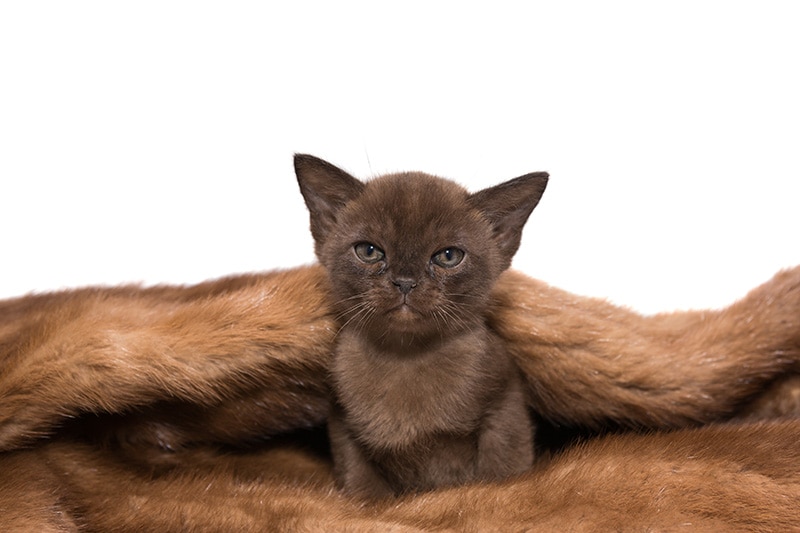
European Burmese kittens will range between $1,200 and $2,400. Potential owners looking to adopt a kitten for show or breeding purposes are looking at spending closer to $2,800 or more. Of course, prices will vary from breeder to breeder, and the age, show record, and quality of the kitten you’re considering.
There are many European Burmese breeders available worldwide. We found kittens available in Croatia, Kansas, Pennsylvania, Los Angeles, Toronto, Spain, Greece, and anywhere between. Finding European Burmese kittens shouldn’t be a problem at all.
 Temperament & Intelligence of the European Burmese
Temperament & Intelligence of the European Burmese
The European Burmese shares many personality traits with the American Burmese cat. They are sleek, graceful, and snuggly. They are very people-oriented and love nothing more than being near their humans and other household pets. They will follow their favorite people around the house so they can be involved in the goings-on.
Adult European Burmese cats remain playful and energetic throughout their entire lives. They are a highly intelligent breed, and one of their most endearing qualities is that they love to learn and perform tricks.
Are These Cats Good for Families? 👪
European Burmese cats are great for families with children because of their sweet and affectionate disposition. They love to receive attention, and because they never stop playing, your kids will have a built-in playmate for your pet’s entire life.
Does This Breed Get Along With Other Pets?
The European Burmese is the perfect breed for households with other cats and even cat-friendly dogs. The key to ensuring your pets create a loving relationship is to introduce them slowly and properly to give them time to adjust to one another.
Things to Know When Owning a European Burmese:
Food & Diet Requirements 🐡
The European Burmese has the same nutritional requirements as any cat. They are obligate carnivores, meaning they must eat animal tissues to get the nutrients they need to thrive. Your cat’s wild ancestors ate a diet containing high amounts of protein, moderate fat, and minimal carbohydrates. Though your kitty isn’t likely to fend for itself in the wild, its diet should still have these general proportions today.
Exercise 🐈
The European Burmese is a highly playful cat that needs a lot of mental and physical stimulation to stay happy and healthy. You should be prepared to set aside time daily to play and interact with your cat.
They are great jumpers and climbers, so you should invest in cat trees and perches to provide that stimulation when you cannot give your kitty your undivided attention.
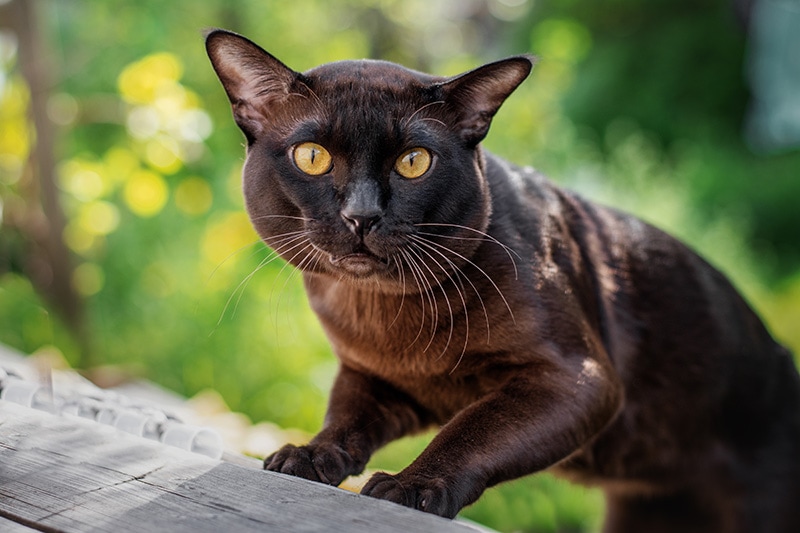
Training 🧶
The European Burmese is a highly intelligent cat that often responds well to training. You can teach your pet to perform tricks, learn basic commands, and even play fetch. Since this breed is dog-like in many ways, you can expect training methods you’d use on a dog to work rather well with your European Burmese.
Grooming ✂️
This breed requires very little help from you in regard to grooming. Their coats are short, satiny, and glossy. Since they’re not big shedders, you’ll only need to brush their coat weekly. Your kitty will take care of the rest of its coat grooming needs.
However, as with all other breeds, you should perform regular nail trims and ear cleaning.
Health and Conditions 🏥
While the European Burmese is a generally healthy breed, they may be prone to certain conditions.
Some sources suggest that the European Burmese living in the United Kingdom, Australia, and New Zealand may be predisposed to developing diabetes mellitus. This breed appears to be four times more likely to develop diabetes than other cats.
This breed may be predisposed to feline orofacial pain syndrome (FOPS), a condition marked by oral discomfort and tongue mutilation.
Since they form such tight bonds with their humans, European Burmese cats may develop separation anxiety if they spend too much time away from their family.
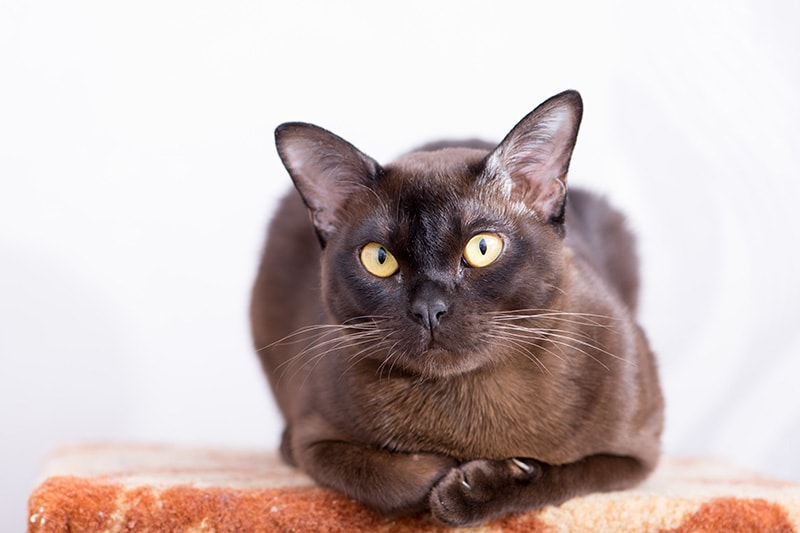
This breed may be born with a condition known as the Burmese head defect. This genetic mutation affects the cat’s head and facial development while still a fetus. If kittens inherit just one affected gene, they will have a brachycephalic head shape. Unfortunately, kittens with two copies of the gene experience severe congenital disabilities incompatible with life.
Gangliosidosis is another condition often seen in Burmese cats. Affected cats will develop neurological signs like an uncoordinated gait, tremors, and involuntary side-to-side eye movements.
This breed may be predisposed to hypokalemia, a condition characterized by muscle weakness due to a lack of potassium in the blood. This condition can be managed through maintenance dosages of potassium.
Pica, a term used to describe the consumption of non-edible materials, is seen most often in certain breeds, including Burmese cats. Affected individuals will eat natural and synthetic fabrics made of materials like wood, leather, rubber, paper, and plastic.
As with all cat breeds, the European Burmese may develop oral conditions like gum and dental disease, as well as skin or eye infections.
- Burmese head defect
- Diabetes
- Feline orofacial pain syndrome
- Pica
- Hypokalemia
- Gangliosidosis
- Oral conditions
- Skin infections
- Eye infections
Male vs Female
The most significant difference between male and female European Burmese cats is that males tend to be bigger and heavier.
There may be minor differences in personality worth noting. While both genders are known for their deeply loving and affectionate nature, how they spend their free time may look different.
Female European Burmese cats are more likely to want to be involved in everything going on in the house. They tend to be a bit more curious and demanding than their male counterparts.
Males tend to be mellow, and happy spending their days lounging around the home.
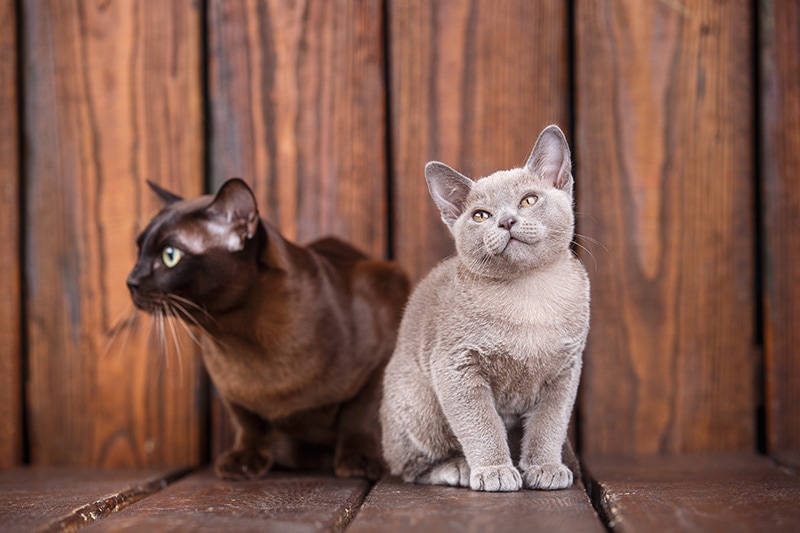
3 Little-Known Facts About the European Burmese
1. The European Burmese revitalized the Burmese gene pool.
During the mid-20th century, the traditional Burmese cat breed faced the risk of inbreeding as only a few were imported to the United Kingdom and the United States. Without a healthy population to breed from, there weren’t enough cats to maintain a healthy gene pool. Inbreeding these cats could cause many health problems and may have even led to the breed’s demise.
Thankfully, European breeders stepped in to help in the outcrossing efforts. They paired the classic Burmese with other breeds to help broaden the gene pool. These successful efforts led to the European Burmese surfacing as a more robust and healthier breed.
2. All modern Burmese cats originated from the same source.
The European and classic Burmese came from the same cat—a short-haired brown female cat named Wong Mau. Wong Mau was bred with a seal-point Siamese named Tai Mau, and then further bred with her son to produce the kittens that soon became the foundation of the Burmese cat we know and love today.
3. The European Burmese is available in ten colors.
According to the Cat Fanciers Association (CFA) are ten officially recognized colors of the European Burmese, including solid colors like brown, blue, chocolate, lilac, red, and cream. They are also seen in parti-colors like brown tortoiseshell, chocolate tortoiseshell, blue cream, and lilac cream.
On the other hand, the CFA lists just four colors for the American Burmese – sable, champagne, blue, and platinum.
Final Thoughts
Though the European and American Burmese breeds do not differ in personality, there are several differences in appearance. The European Burmese are leaner and more athletic than their American counterparts. They have wedge-shaped heads and small pointed ears, while the American cats have heads and ears that are slightly wider. The European Burmese’s eyes are almond-shaped, compared to the American’s rounder eyes.
Personality-wise, the European Burmese is an affectionate, intelligent, social, and playful little dynamo. They love to spend time with their family members almost to a fault, as they can develop social anxiety if separated for too long.
As with most pedigree cat breeds, there are several health conditions the European Burmese may be predisposed to. We’d recommend investing in health insurance if you plan to adopt a kitten of this breed for peace of mind if the unthinkable happens.
Featured Image Credit: fotoliza, Shutterstock










